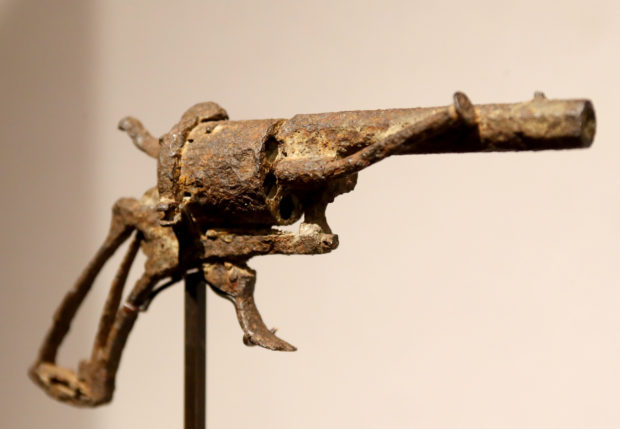By: Fiachra Gibbons via Agence France-Presse
The revolver with which Vincent van Gogh is believed to have shot himself sold for 162,500 euros ($182,000) at a Paris auction on Wednesday — nearly three times the estimate.
Billed as “the most famous weapon in the history of art”, the rusty 7mm Lefaucheux revolver was bought by a private collector with a telephone bid.
The troubled Dutch painter died in July 1890 and experts believe he shot himself with the revolver in a field near Auvers-sur-Oise, a village north of Paris where he spent the last few months of his life.
Discovered by a farmer in 1965 in the same field, the gun has previously been exhibited at the Van Gogh Museum in Amsterdam.
But the sale was hit by controversy on the eve of the auction as the Van Gogh Institute, which looks after the village inn where the artist spent his last days, condemned the sale.
“Nothing suggests that the remains (of the gun) are formally linked with the death of Van Gogh,” it said in a statement, deploring the “commercialisation of a tragedy which deserves more respect”.
While Art Auction, which sold the gun, said there is no way of being absolutely certain it is the fatal weapon, they insisted tests showed it has been in the ground for 75 years, which would fit.
The Dutch artist had borrowed the gun from the owner of the inn.
He died 36 hours later after staggering back wounded to the inn in the dark.
The bullet extracted from Van Gogh’s chest was the same calibre as the one used by the Lefaucheux revolver.

Accident or suicide?
Nor was it his first dramatic act of self-harm. Two years earlier, he cut off his ear which he offered to a woman in a brothel in Arles in southern France.
Auction Art said the farmer who found the gun in 1965 gave it to the former owners of the inn at Auvers-sur-Oise, whose family are now selling it.
“Technical tests on the weapon have shown the weapon was used and indicate that it stayed in the ground for a period that would coincide with 1890,” it said.
“All these clues give credence to the theory that this is the weapon used in the suicide.”
While most art historians agree Van Gogh killed himself, that assumption has been questioned in recent years, with some claiming the fatal shot may have been fired accidentally by two local boys playing with the weapon in the field.
That theory won fresh support from a new biopic of the artist starring Willem Dafoe, “At Eternity’s Gate”, in which the gun goes off after the two brothers get into a struggle with the bohemian stranger.
The film’s director, the renowned American painter Julian Schnabel, told AFP that Van Gogh had painted 75 canvasses in his 80 days at Auvers-sur-Oise and was unlikely to be suicidal.
‘He was not at all sad’
The legendary French screenwriter Jean-Claude Carriere, who co-wrote the script with Schnabel, insisted that there “is absolutely no proof he killed himself”.
“Van Gogh was working constantly. Every day he made a new work. He was not at all sad.
“Do I believe that Van Gogh killed himself? Absolutely not!” Carriere declared when the film was premiered at the Venice film festival last year.
He said Van Gogh painted some of his best work in his final days, including his “Portrait of Dr Gachet,” his friend the local doctor who later tried in vain to save his life.
That canvass set a world record when it sold for $82.5 million in 1990.
Art Auction acknowledged that the gun could also have been hidden or abandoned by the two boys.
While the Van Gogh gun may have nearly tripled its estimate, it is still well short of the 434,500 euros ($460,000) paid two years ago for the gun which the French writer Paul Verlaine tried to kill his lover and fellow poet Arthur Rimbaud.
The sale also comes as crowds are flocking to an immersive Van Gogh exhibition in Paris which allows “the audience to enter his landscapes” through projections on the gallery’s walls, ceilings and floors.
“Van Gogh, Starry Night” runs at the Atelier des Lumieres in the east of the French capital until December.